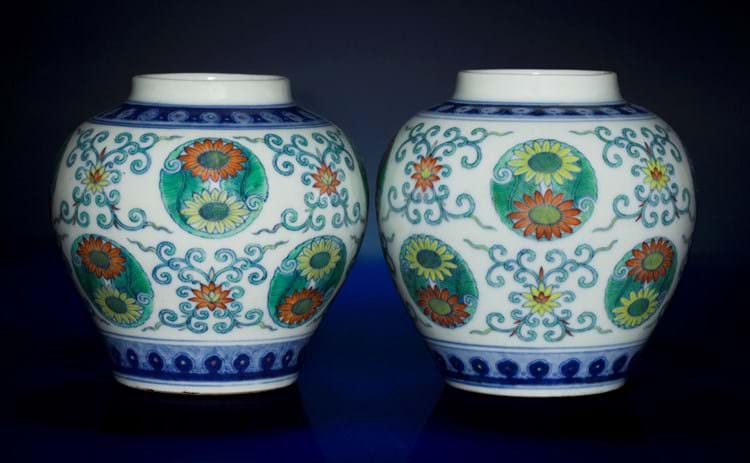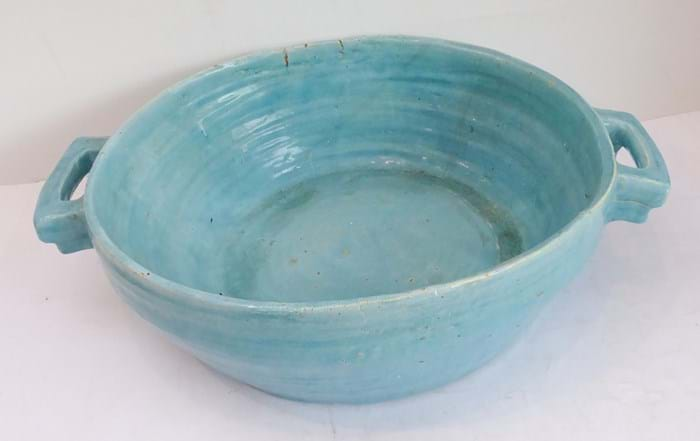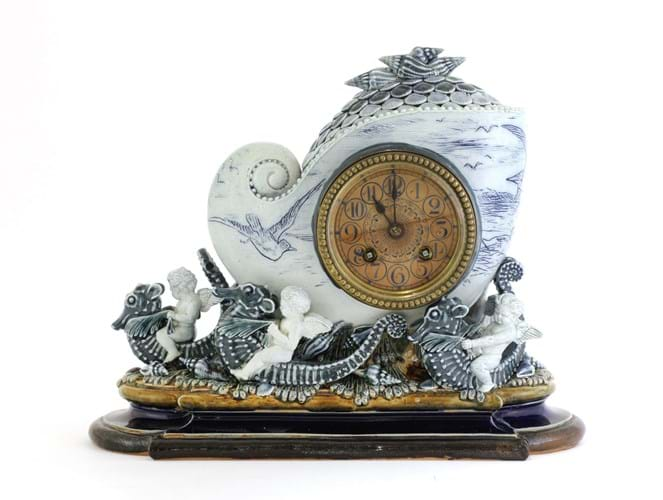
A near pair of Qianlong mark and period doucai ‘lotus and chrysanthemum’ jars, £46,000 at Roseberys.
1. Qianlong jars – £46,000
This near pair of Qianlong mark and period doucai jars were a charity shop find for a keen-eyed London vendor. An old paper label to the base of one reading ‘Chen Lung’ suggested they might just be worth the outlay of a £20.
The 5in (12cm) jars, that differ in the border decoration, are finely painted in underglaze blue and enamelled in iron-red, yellow and green enamels with a pattern of lotus and chrysanthemum blooms. The type is believed to be modelled after Chenghua prototypes. Originally, they would have flat-topped covers with similar decoration.
Pairs with covers have brought as much as £200,000 in recent years.
This spectacular find, entered for sale at Roseberys’ Chinese, Japanese & South East Asian Art sale on May 16-17 with a guide of £30,000-£50,000, sold at £46,000. The vendor has promised to make a substantial donation to the charity concerned.
2. Omega Workshops bowl – £5800
Estimated at £20-40, this large ‘continental’ turquoise-glazed bowl for a surprise £5800 at Tayler & Fletcher in Bourton-on-the-Water on May 13. The clue to its appeal was its very handmade appearance and the impressed mark to the base with the Greek letter omega.
Although Omega Workshops work was typically produced anonymously, most of the pottery is thought to have been made by Roger Fry. He began designing and making his own ceramics in the autumn of 1913, learning the basics of throwing and glazing clay first under the Surrey potter George Schenk and then at Carter & Co in Poole.
While Fry’s technical skills were limited, these wares have since become important to the Bloomsbury Group story and an addendum to the wider history of British studio ceramics. Only rarely do they come to the market.
At 22in (55cm) this bowl must rank among the largest pieces made by Fry. Firing it presented some challenges with three 2cm cracks appearing in the body and a lot of kiln dirt mottling the surface. The underside of the foot is unglazed.
The price likely represented something of a bargain for the online buyer.
Ceramics by the Omega Workshops rose to unprecedented heights at Woolley & Wallis in March 2022. A small collection of pottery by Roger Fry ranged from a broken and reglued plate with blue outline decoration at £2500 to £10,000 for a charger in a monochrome tin glaze with a single turquoise splash to the rim. Guided at £1000-1500 but sold at a mighty £20,500 was a 7in (17cm) diameter plate painted with two cranes in red lustre on a tin-glaze.
Despite the best efforts of its directors, Omega struggled financially and closed after six difficult years. In June 1919, as an ‘everything must go’ sale began, Fry wrote to his friend Michael Saddler saying: “The utter indifference…of the public to what we have attempted has bought Omega to disaster.”
3. Chinese export teapot – £10,000
This rare Chinese export teapot, cover and stand is painted with the arms and motto of the Dutch Republic and the cypher of the Verenigde Oost Indische Compagnie better known as the Dutch East India Company.
The inscription reads Concordia Res Parvae Crescunt 1728.
The design is copied from one side of a silver coin (the ducatoon) issued by the Company in 1728 for use in the Far East. So faithfully did the Chinese artist follow his brief that even the ribbed milling of the coin is imitated in the rim of the saucer and the mouth rim of the teapot and cover.
The service is thought to have been commissioned by the VOC to mark the launch of the new coinage and may have been used by its employees at various official bases throughout the Far East.
Several pieces reside in key museum and private collections and occasionally they come to auction. A cup and saucer of this design which was sold at Christie's New York in 2012 as part of the Frellinghuysen collection of Chinese export porcelain for $9500.
This teapot, cover and stand were from an old Western private collection and offered as part of the Asian art sale at Bonhams Knightsbridge on May 15. Guided at £1500-200, they took £10,000.
4. Jim Partridge oak bookcase – £3400
A cache of design objects consigned by British textile artist and designer Ann Sutton (b.1935) were offered as part of the Lyon & Turnbull Modern Made sale at The Mall Galleries, London on April 28.
De-cluttering with the sale of 43 lots from her very personal art collection, Sutton chose to part with some of the cutting-edge 1980s furniture created for her Arundel studio by former student Jim Partridge (b.1953). The artist cabinet-maker recalled that the pair worked together on a new kind of furniture that, while certainly not fine cabinet making, had plenty of attitude.
A two-seat plank bench (£4000) and a warped stool (£2400), both from 1984 as well as a bookcase from 1987 (£3400) were all included in the sale. Made in the saw-cut and scorched oak that became Partridge’s signature, he described these pieces as pioneers of “a new language for woodworking. I had exhibited this work before, but Ann was the first to buy it, to understand, trust and encourage the qualities I was hoping to achieve”.
A total of 22 lots by Partridge included a series of small-scale domestic wares – an egg rack (1986) and a toast rack (1984) sold for £650 and £550 respectively – and a series of bowls with estimates sold for prices between £320 and £1100.
5. Doulton Lambeth Nautilus Clock – £7000
This remarkable Nautilus Clock sold for £7000 when Sworders offered the first part of the Ann Turner collection of Doulton pottery in Stansted Mountfitchet on May 16. Turner, a musician whose husband worked for a Swiss bank, enjoyed a lifelong passion for Doulton Lambeth wares and bought fine quality pieces at auction and through dealers across more than 40 years. Her house in Brookmans Park in Hertfordshire was adorned floor to ceiling with her collection.
The clock case, modelled as a nautilus shell supported by cherubs riding seahorses, is an 1878 design by George Tinworth with the incised decoration of gulls and other seabirds done by Hannah Barlow.
The distinctive crack and staining to the dial suggest it is the same clock sold for £3400 at Cotswolds auctioneers Moore Allen & Innocent in 2015. Another version resides at the Museum of Applied Arts and Sciences in Sydney.
Tinworth worked for Doulton from 1867 until his death in 1913, at the age of 70.
He produced a series of whimsical clock cases during his long tenure including the Menagerie Clock, the most ambitious of all the ‘Tinworth mouse’ groups. The example that appeared for sale at Chilcotts in Honiton in January took £9200.










